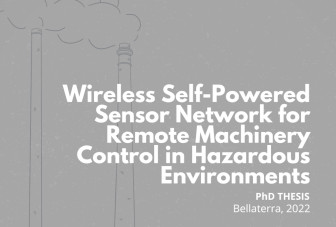POSPOSAT -- Defensa de tesi de Roger Nicolàs Alegret
POSPOSAT --
Defensa de tesi de Roger Nicolàs Alegret el pròxim ???. Sala de Graus de l’Escola d’Enginyeria – Edifici Q.

POSPOSAT --
Doctorand: Roger Nicolàs Alegret.
Títol: Wireless Self-Powered Sensor Network for Remote Machinery Control in Hazardous Environments.
Director/a: Carles Ferrer Ramis / Raúl Aragonés Ortiz.
Data i hora lectura: ????.
Lloc lectura: Sala de Graus de l’Escola d’Enginyeria – Edifici Q.
Programa de Doctorat: Enginyeria Electrònica i de Telecomunicació.
Departament on està inscrita la tesi: Departament de Microelectrònica i Sistemes Electrònics.
Abstract
Current industries leave a big ecological footprint that needs to be reduced to preserve our resources. For it, big industries are leading new researches to move to more environmental-friendly technologies.
The Industrial Internet of Things, is the new game-changer of the next industrial revolution, leading to Industry 4.0. Traditional automation players have a serious challenge to become competitive in the overall technology and cost revolution considering new stakeholders, which include the vast majority of the start-ups and scale-ups, who are showing their ability to create new ready-to-market solutions.
However, the number of linked devices is growing rapidly due to the growing IoT, which will soon cause a scaling issue owing to their energy demand. Many devices will be embedded in the environment, at hard or expensive locations to connect with cables, putting them at a disadvantage in terms of resources. Most significantly, replacing batteries for thousands of devices is unthinkable. The expense of maintenance and intervention may be a stumbling block to adopting this new paradigm. As a result, one of the problems in assuring the widespread use of wireless sensing devices is lowering their energy costs. To meet this transition, new approaches are clearly necessary.
In this work we explain an innovative technology which has the ability to introduce edge-computing in the node in combination with energy harvesting, which allows the device to work without the need of batteries. Also, as all the computations are performed in the node, it allows the use of long-range communication protocols.
Energy Harvesting is a key enabler to operate the nodes without requiring batteries. Thus, finding methods to maximize the energy harvested is quite reasonable. However, there is one more concept to take into account. A well-sized harvester could provide enough energy to operate a device without needing any other energy buffer. Under this hypothesis, the present work analyses how a wireless sensor network powered by waste heat can be achieved and the effects of considering the energy harvested to be enough to power the nodes.
To this end, the present work is structured using a bottom-up approach. First, we go through the history of sensing in the Industry to understand why the Industry applies the methods and procedures it uses today and the business behind those actions. After this, we analyze and build a wireless sensor network powered by waste heat, which gives us a clear idea of how the system must work. Finally, a reinforcement learning algorithm is implemented to maximize the node's working mode, being able to make the node work even if the energy scavenger is not giving all the energy it should be giving.
In conclusion, energy harvesting is a feasible solution for powering wireless sensor nodes and eliminating batteries and supercapacitors from the devices. The proposed solution is a working proof of concept which needs to scale in levels of technology. However, it lays the foundation for developing Industrial IoT nodes that only use a scavenger as a direct power source.